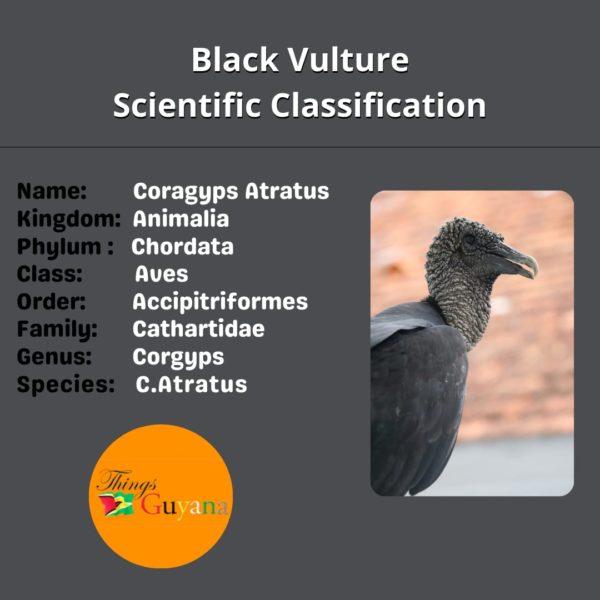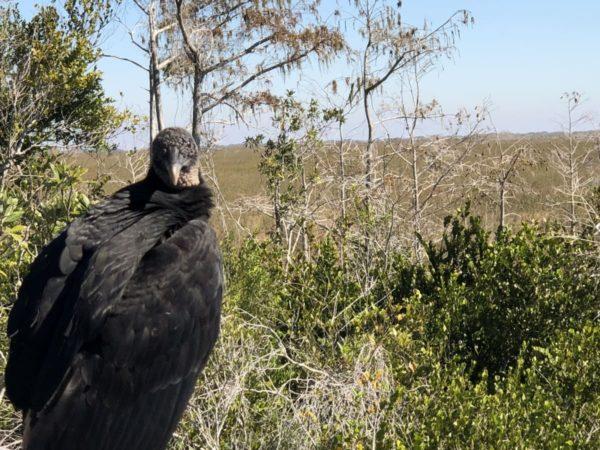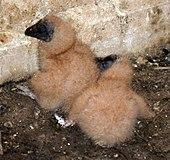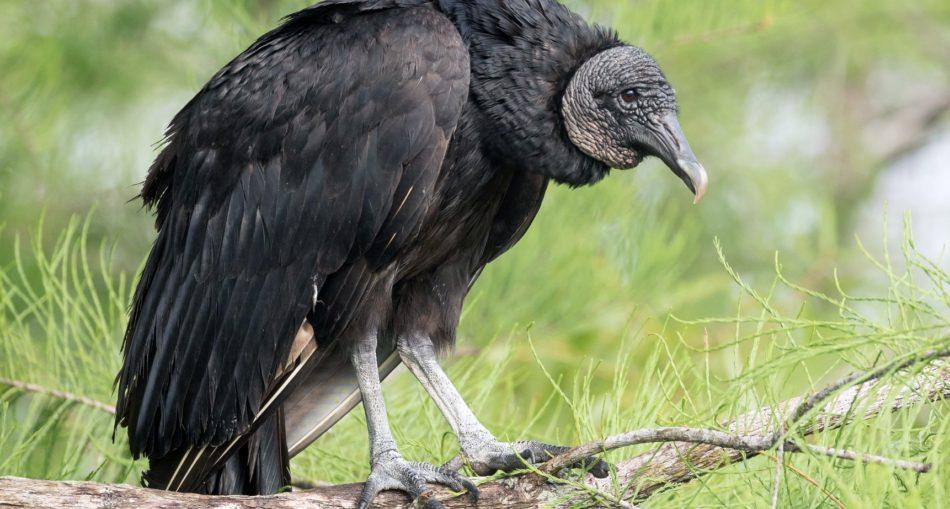The black vulture looks like it could be the mascot for a metal band or something you would see in a nightmare, but despite their uniquely terrifying appearance these creatures also have quite a few interesting behavioural traits. Let us take a look into these creatures’ lifestyle.

Description
The black vulture is shorter and stockier than the turkey vulture and reportedly dominates it
at carcasses. It is a fairly large scavenger measuring 22 to 29 inches in length and a magnifcent wingspan of 52 to 66 inches. These vultures weigh around 3.8 to 5.1 lbs. Their plumage is a glossy black colour, with a bare black head, and neat white stars under the wingtips. The head and neck are featherless and the skin is dark gray and wrinkled. The iris of the eye is brown. The legs are grayish-white, while the two front toes of the foot are long and have small webs at their bases. The tail is short and square, barely reaching past the edge of the folded wings.
Habitat

Photo of vulture in its habitat. Photo Source: https://pixnio.com/media/wildlife-bird-vulture-nature-outdoors
The black vulture prefers open land with patches of wood or brush. It can also be found in moist lowland forests, shrublands and grasslands, wetlands, swamps, pastures, and heavily logged former forests. It prefers lowlands and is rarely seen in mountains. It is commonly observed soaring or perched on fence posts or dead trees.
Its range includes Mexico, Central America, and most of South America.
Diet
Black Vultures sometimes feed on the same carcass for several days. Carcasses of large mammals are the most common food sources. Individuals prefer to feed on fresh carcasses but consume decaying meat as well. Occasionally Black Vultures capture live prey, most of which are young, weak, or sick small mammals or birds. Black Vultures locate their prey through sight or by following other vultures to carcasses. These birds tend to become very aggressive while feeding and will even end up in fights with turkey vultures who are also trying to eat the same carcass.
Reproduction
Black vultures being breeding as early as January. Pairs are formed after a ground courtship ritual in which several males circle a female with their wings partially open as they strut and bob their heads. They occasionally perform courtship flights, diving or chasing each other over their preferred nesting site.
Take a look at this video of a black vulture’s courtship dance and call – https://www.youtube.com/watch?v=mekb7coLS0o

Photo of the black vulture’s hatchlings. Photo Source: https://en.wikipedia.org/wiki/Black_vulture#/media/File:Black_Vulture_hatchlings.jpg
The black vulture lays its eggs on the ground in a wooded area, a hollow log, or some other cavity, seldom more than 3 m (10 ft) above the ground. While it generally does not use any nesting materials, it may decorate the area around the nest with bits of brightly colored plastic, shards of glass, or metal items such as bottle caps. The egg is oval and on average measures 7.56 cm × 5.09 cm (2.98 in × 2.00 in). Both parents incubate the eggs, which hatch after 28 to 41 days. Upon hatching, the young are covered with small, fluffy feathers. Both parents feed the nestlings, regurgitating food at the nest site. The young remain in the nest for two months, and after 75 to 80 days they are able to fly skillfully.
Symbolism
The ancient Maya viewed vultures as important entities in their daily lives. As a symbol of cleansing and renewal, these birds could transform death into life. Vultures are common figures illustrated in hieroglyphs, the few remaining Maya codices (Maya books), ceramics, and in myths. In one tale, vultures circle the Maya fields like guardian angels of the crops.
Fun Facts
- Black vulture mating pairs may remain together and reuse a successful nesting site for many years.
- Both the male and female parents take turns incubating their eggs.
- Black vultures usually feed together in large groups and are so aggressive that other vulture species will stay away.
- When startled, a black vulture may regurgitate partially digested food to discourage predators and lessen its weight for flight.
- Farmers watch the skies when they need to locate one of their cows giving birth. The vultures fly high above the cows, keeping an eye out for the afterbirth.
- Vultures will often urinate on their own legs in order to increase evaporative cooling in the hot summer months.
- These awesome birds are able to eat diseased meat without getting ill.
References
- https://en.wikipedia.org/wiki/Black_vulture
- https://seaworld.org/animals/facts/birds/black-vulture/#:~:text=Fun%20Facts,vulture%20species%20will%20stay%20away.
- https://yucatantoday.com/en/cheries-bird-month-black-vulture/#:~:text=The%20ancient%20Maya%20viewed%20vultures,could%20transform%20death%20to%20life.
Discover more from Things Guyana
Subscribe to get the latest posts sent to your email.







